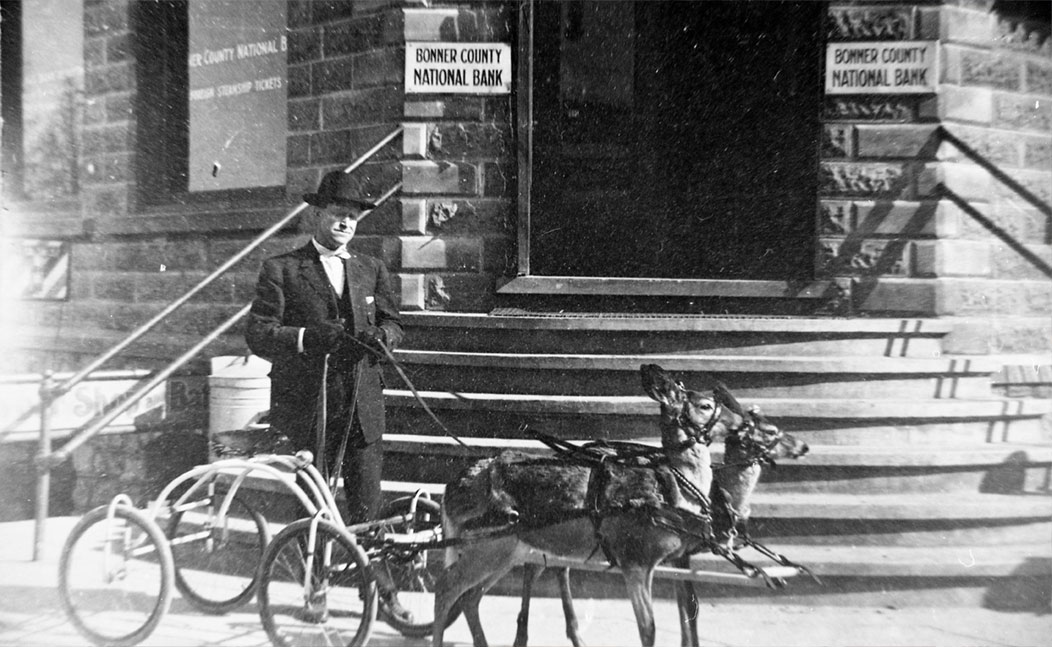Pictured in History
From the Winter 2024 Issue
Meet Sandpoint's most famous pair of deer, Babe and Buster

Passersby were amused by a novel occurrence on Sandpoint streets in February 1911, when they encountered a pair of small, white-tailed deer harnessed to a single-seat buggy and driven by their sharp-dressed owner Frank Clements.
Describing it as, “A sight that is unusual on the streets of any city in the west,” the Northern Idaho News reported the deer “were equipped with a neat set of light harness and were quite tractable, willingly obeying their master’s desires as to the route to be taken.”
Clements worked as the “night man” at the city stables, and had purchased the deer four months earlier when they were only a few days or weeks old. Named Babe and Buster, Clements’ unusual pets joined the other members of his menagerie, which included a black bear and cinnamon bear.
Babe and Buster were instantly newsworthy and by late May 1911 Clements was taking them on the road. He had signed a contract to tour Babe and Buster on the Orpheum vaudeville theater circuit, earning $100 per week for the attraction—more than $3,000 in current value.
“It is claimed this is the only team of deer broken to harness outside of the reindeer of the Arctics,” the Review reported. “They not only drive but Clements has taught them to stand upon their hind feet, to count, and do other tricks common to horses and dogs.”
The show must have been a hit, as on Aug. 4, 1911, the papers carried a dispatch from the Seattle Times announcing Clements had been making a splash in the big city and would now drive Babe and Buster overland from Seattle to New York.
“During the last week Clements has been driving his steeds down the business streets of Seattle, attracting considerable attention because of the beauty and perfect mating of the two deer,” the Times wrote, later recounting that the deer had been trained to “lie down at command, feign dead, and do similar tricks.”
There were a few cracks appearing in the entertaining facade, however. The Times reported Clements had used his bears to train Babe and Buster—“frightening the deer so that they would run to him for protection.” Meanwhile, the Pend Oreille Review added that Clements hadn’t actually made the Orpheum circuit, “but piled up a good lot of American dollars by exhibiting the deer on the streets in Spokane and shoving out postal picture cards of them as fast as he and an assistant could take in the money.”
Legal trouble soon followed. Just days after the triumphant announcement of Clements’ transcontinental trek, Spokane photographer M.B. Martin filed a lawsuit alleging he’d been swindled of his promised cut of the proceeds from the postcard sales and asked a judge for compensation. He’d also loaned Clements money to help pay for him to leave town for the coast.
In February 1918 the Pend Oreille Review wrote that Clements had appeared in an Associated Press photo with a team of reindeer in his new hometown of Chicago, where he’d driven the animals through the streets during a recent blizzard to deliver milk to families with babies, “supplying many kiddies who otherwise would have had to go without.”
The story got the Review reminiscing about the days when Clements would hitch up Babe and Buster and “take the Sandpoint kids on many a jolly sleigh ride back of his trained deer.”
After that, the life of Babe, Buster, and their ambitious owner faded away into certain myths—including that they’d been displayed at the World’s Fair in Chicago (they weren’t, as the fair took place in 1893) and an exposition in Seattle in 1909, a year before their birth.
In their time, the trio cut a striking figure in the region and, no matter what, Babe and Buster can be regarded as among the most famous and well-traveled deer in local history.




Leave a comment